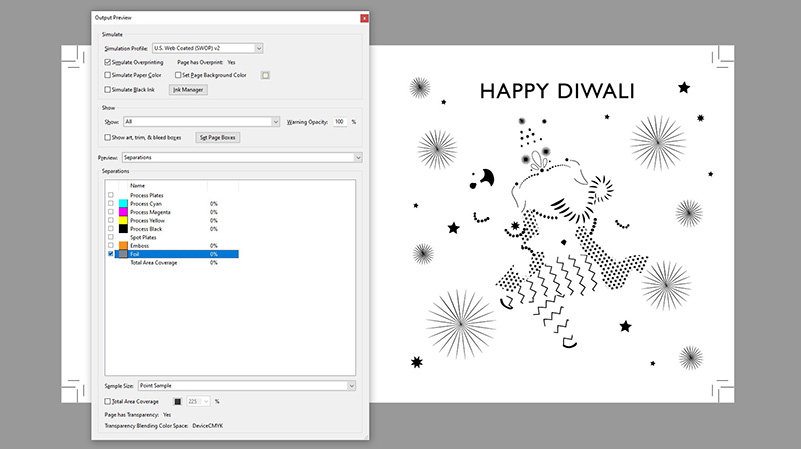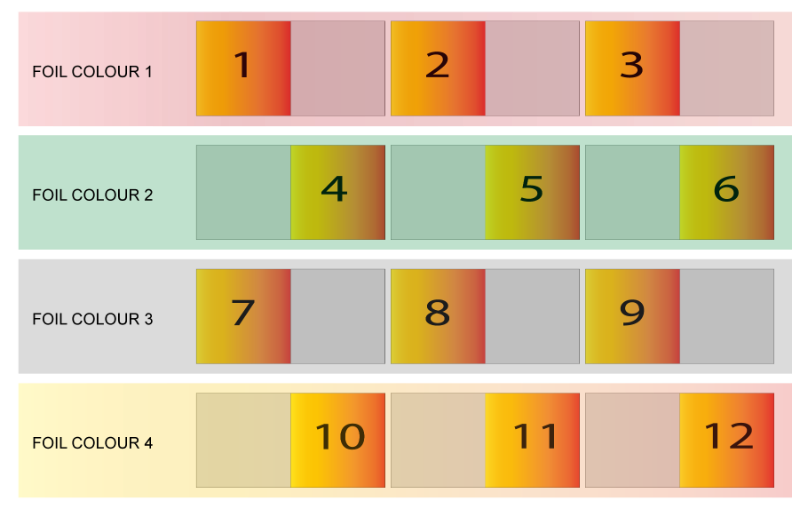It’s common for greeting cards to have additional layers of pizzazz in the form of glitter, foil or emboss. In part 6 of this 8 part series, we’ll discuss how to communicate these “finish layers” to your printer.
- Introduction
- Card Sizes: things to consider
- Image Resolution
- Understanding Colour modes (CMYK vs RGB vs Pantone)
- Bleed and Trim
- Finishing Layers (Foil, flitter, emboss) – you are here
- Getting Files Press Ready Checklist
- Working with your Printer
Types of Finish
These are some of the most common types of finish that are applied to greeting cards.
- Glitter / Flitter : thermographically applied sparkle available in a variety of colours
- Emboss / Deboss : an imprecision of raised or lowered areas created by applying pressure using a metal die.
- Foil : Also applied using a die, leaving a metallic finish on specified areas of the card.
The Finish Layers
You need to let your printers know which areas of the card require what type of finish. It’s important to speak to your printer about how they want the file set up, as each printer may have slightly different ways of working. But broadly speaking, this is usually done by adding an additional layer for each finish to the artwork file in a design software such as Adobe Photoshop or Adobe InDesign.
The example below illustrates a real world example of a foil and embossed card, using the Adobe Acrobat Print Preview tool to demonstrate the layers.
This is the standard four colour process print showing the combination of the CMYK plates:

The area that needs to be raised is shown in a separate Emboss layer. This will be used to create the Emboss die:

The foil area will require a separate die and is contained in a separate layer:

Lining up the finish layers with the colour layers (or other finish layers) is called Registration. Printers these days are pretty accurate with their registration, but there can be slight movement between the passes on press for each plate. For this reason it’s advisable to avoid having intricate designs that rely on finish layers landing in exact positions.
Here’s the finished card from the above separations:
Visualising Finishes
It can be quite tricky to visualise how different finishes will look. Flitter can be mocked up with a glue stick and some patience to see how the finished card will look. But Foil and emboss are harder to visualise.
Being able to predict how a card will turn out when it has foil and emboss areas will come with practice and experience. You can ask your printers to supply you with swatches of the foil colours they use and also ask for samples of cards they have printed previously. Get as much advice as you can to avoid mistakes – foil and emboss dies come at a cost!
How many Foil / Glitter colours can you have on a print run?
It’s worth noting that there are limits to the number of foil or flitter colours you can have on a print run.
For Flitter, you may be able to have a different colour for each card, but speak to your printers about the cost implications of this. However if you use encapsulated glitter (where the glitter has a thin laminate applied over the top) then you are probably limited to just one colour for the whole sheet.
Foil is slightly more nuanced, due to the way the foiling machines work. The foil rolls across a strip of the sheet, so all the cards in that strip will have the same foil colour. But multiple foils can be applied to the same sheet. By way of example, you many be able to have 4 foil colours in a 12 card print run. You’d have to plan your range so that the cards are in sets of 3, each receiving the same foil colour.
Again, each printer works slightly differently, so speak to your print partner before designing you full range.
Die Ownership
Dies for foil and emboss are usually paid for by the publisher, and so the publisher has ownership. The printer usually keeps hold of them for you. If you decide to use a different printer for a subsequent print, you can ask the old printers to send the dies to the new printer. The printers in the Greeting Card industry (the GCA member printers) regularly pass on dies upon request, so don’t be afraid to ask if the need arises.
Environmental Considerations
Glitter/Flitter has been popular over the years. However it is basically a form of microplastic and has thus fallen out of favour in recent times as environmental considerations have impacted design choices and consumer buying choices. That doesn’t mean you need to necessarily rule out this finish, as biodegradable glitter is available. For more information on Greeting Cards and the Environment, visit the Environment section of the GCA Library.


